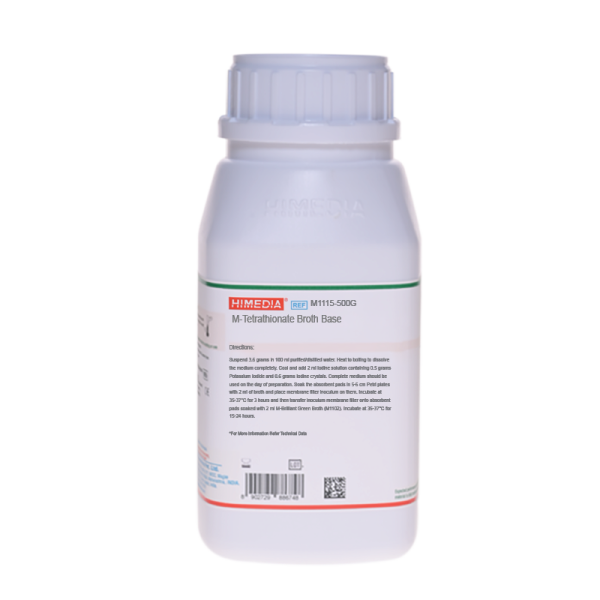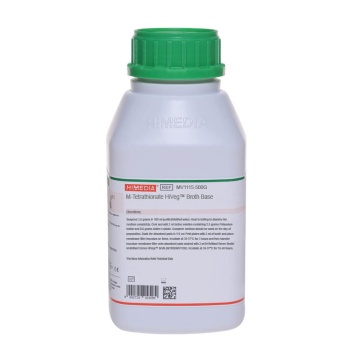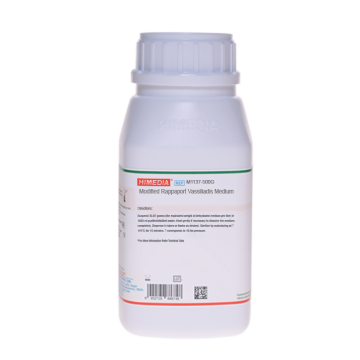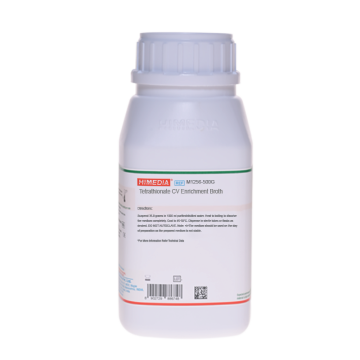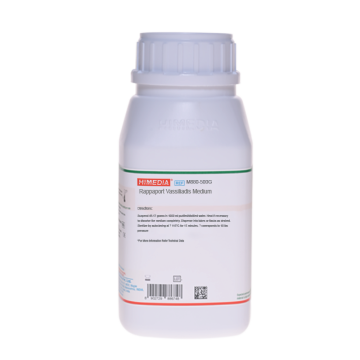 Your enquiry has been submitted
Your enquiry has been submitted
M-Tetrathionate Broth Base
Quantitative Tests#CC293D
Intended Use
Recommended for selective enrichment of Salmonellae using membrane filter technique.
Composition**
| Ingredients | g/L |
|---|---|
| Proteose peptone | 5.000 |
| Bile salts | 1.000 |
| Sodium thiosulphate | 30.000 |
| Final pH (at 25°C) | 8.0±0.2 |
**Formula adjusted, standardized to suit performance parameters
Directions
Suspend 3.6 grams in 100 ml purified/distilled water. Heat to boiling to dissolve the medium completely. Cool and add 2 ml Iodine solution containing 0.5 grams Potassium Iodide and 0.6 grams Iodine crystals. Complete medium should be used on the day of preparation. Soak the absorbent pads in 5-6 cm Petri plates with 2 ml of broth and place membrane filter inoculum on them. Incubate at 35-37°C for 3 hours and then transfer inoculum membrane filter onto absorbent pads soaked with 2 ml M-Brilliant Green Broth (M1102). Incubate at 35-37°C for 15-24 hours.
Principle And Interpretation
Enrichment media favour the multiplication of a particular species as a step towards their isolation in pure culture (1). M-Tetrathionate Broth is prepared as per the formulation of Kabler and Clark (2) for selective enrichment of Salmonella using membrane filter technique. The formulation is similar to Tetrathionate Broth except calcium carbonate. Tetrathionate Broth Base was originally described by Mueller (3) and found that the medium selectively inhibits coliforms and permits the unrestricted growth of enteric pathogens.
Proteose peptone provides nitrogenous and carbaneous nutrients for the bacterial metabolism. Tetrathionate is formed by the addition of iodine solution. The selectivity of the medium depends upon the ability of thiosulphate and tetrathionate in combination, to suppress commensal organisms (4,5). Only those organisms possessing the tetrathionate reductase enzyme can grow on this medium. Bile salts inhibit many gram-positive microorganisms.
Type of specimen
Water samples
Specimen Collection and Handling:
Soak sterile cotton absorbent pads placed in 5-6 cm Petri plates with 2 ml of M-Tetrathionate Broth Base and place the membrane filter inoculum on them. Incubate at 35-37°C for 3 hours and then transfer inoculum membrane filter onto absorbent pads soaked with 2 ml M-Brilliant Green Broth (M1102). Incubate at 35-37°C for 15-21 hours. After M-BGB incubation, add urease test reagent (urea-20 gram, bromothymol blue 0.16 gm and phenol red 0.2 grams in 1000 ml distilled water) to absorbent pads and allow to set for 15-20 minutes to permit reagent to diffuse throughout the medium for development of colour. After use, contaminated materials must be sterilized by autoclaving before discarding.
Warning and Precautions :
Read the label before opening the container. Wear protective gloves/protective clothing/eye protection/face protection. Follow good microbiological lab practices while handling specimens and culture. Standard precautions as per established guidelines should be followed while handling specimens. Safety guidelines may be referred in individual safety data sheets.
Limitations
- Further biochemical and serological tests must be carried out for further identification.
- Individual organisms differ in their growth requirement and may show variable growth patterns on the medium.
- Each lot of the medium has been tested for the organisms specified on the COA. It is recommended to users to validate the medium for any specific microorganism other than mentioned in the COA based on the user's unique requirement.
Performance and Evaluation
Performance of the medium is expected when used as per the direction on the label within the expiry period when stored at recommended temperature.
Quality Control
Appearance White to light yellow homogeneous free flowing powder
Colour and Clarity of prepared medium Amber coloured clear solution without any precipitate
Reaction Reaction of 3.6% w/v aqueous solution at 25°C. pH : 8.0±0.2
pH 7.80-8.20
Cultural Response Cultural characteristics observed with added Iodine solution (containing Potassium Iodide and Iodine crystals), after an incubation at 35-37°C for 18-24 hours
| Organism | Recovery (by Mile Misra test) | Colour of colony (on membrane filter) | Colour (after addition of urease test reagent) |
|---|---|---|---|
| Escherichia coli ATCC 25922 (00013*) | fair-good | yellow-green | yellow |
| Salmonella Enteritidis ATCC 13076 (00030*) | good-excellent | pink-red | red |
| Salmonella Typhimurium ATCC 14028 (00031*) | good-excellent | pink-red | red |
Key: *Corresponding WDCM numbers.
Storage and Shelf Life
Store between 10-30°C in a tightly closed container and use freshly prepared medium. Use before expiry date on the label. On opening, product should be properly stored dry, after tightly capping the bottle in order to prevent lump formation due to the hygroscopic nature of the product. Improper storage of the product may lead to lump formation. Store in dry ventilated area protected from extremes of temperature and sources of ignition. Seal the container tightly after use. Product performance is best if used within stated expiry period.
Disposal
User must ensure safe disposal by autoclaving and/or incineration of used or unusable preparations of this product. Follow established laboratory procedures in disposing of infectious materials and material that comes into contact with sample must be decontaminated and disposed of in accordance with current laboratory techniques (6,7).
Reference
- Collee J. G., Fraser A. G., Marmion B. P., Simmons A., (Eds.), Mackie and McCartney, Practical Medical Microbiology, 1996, 14th Edition, Churchill Livingstone.
- Kabler P. W. and Clark H. F., 1952, Am. J. Public Health, 42:390.
- Mueller G. M., 1923, Compt. Rend. Seo. Biol., 89:434
- MacFaddin J. F., 1985, Vol. I, Media for the Isolation-Cultivation-Identification-Maintenance of Medical Bacteria, Williams and Wilkins, Baltimore.
- Pollock M. R. and Knor R., 1943, Biochem J., 37: 476
- Isenberg, H.D. Clinical Microbiology Procedures Handbook 2nd Edition.
- Jorgensen, J.H., Pfaller, M.A., Carroll, K.C., Funke, G., Landry, M.L., Richter, S.S and Warnock., D.W. (2015) Manual of Clinical Microbiology, 11th Edition. Vol. 1.
| Product Name | M-Tetrathionate Broth Base |
|---|---|
| SKU | M1115 |
| Product Type | Regular |
| Physical Form | Powder |
| Origin | Animal |
| Packaging type | HDPE |
| References | 1. Collee J. G., Fraser A. G., Marmion B. P., Simmons A., (Eds.), Mackie and McCartney, Practical Medical Microbiology,1996, 14th Edition, Churchill Livingstone |
| Customized Product Available | No |



